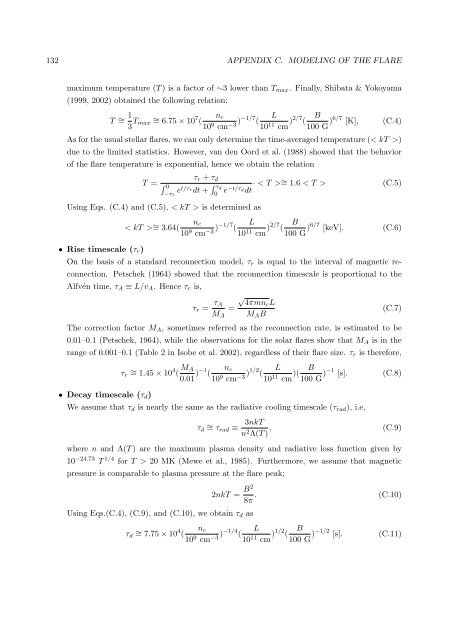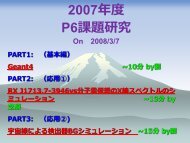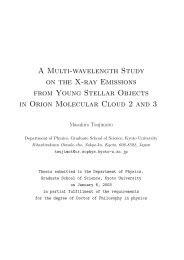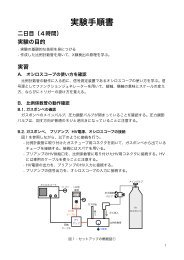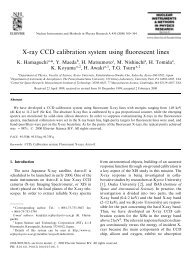X-ray Study of Low-mass Young Stellar Objects in the ρ Ophiuchi ...
X-ray Study of Low-mass Young Stellar Objects in the ρ Ophiuchi ...
X-ray Study of Low-mass Young Stellar Objects in the ρ Ophiuchi ...
You also want an ePaper? Increase the reach of your titles
YUMPU automatically turns print PDFs into web optimized ePapers that Google loves.
132 APPENDIX C. MODELING OF THE FLAREmaximum temperature (T ) is a factor <strong>of</strong> ∼3 lower than T max . F<strong>in</strong>ally, Shibata & Yokoyama(1999, 2002) obta<strong>in</strong>ed <strong>the</strong> follow<strong>in</strong>g relation;T ∼ = 1 3 T max ∼ = 6.75 × 10 7 n cL B(10 9 cm −3 )−1/7 (10 11 cm )2/7 (100 G )6/7 [K], (C.4)As for <strong>the</strong> usual stellar flares, we can only determ<strong>in</strong>e <strong>the</strong> time-averaged temperature (< kT >)due to <strong>the</strong> limited statistics. However, van den Oord et al. (1988) showed that <strong>the</strong> behavior<strong>of</strong> <strong>the</strong> flare temperature is exponential, hence we obta<strong>in</strong> <strong>the</strong> relationT =τ r + τ d∫ 0−τ re t/τ r dt +∫ τd0 e−t/τ d dt· < T > ∼ = 1.6 < T > (C.5)Us<strong>in</strong>g Eqs. (C.4) and (C.5), < kT > is determ<strong>in</strong>ed as• Rise timescale (τ r )< kT > ∼ n cL B= 3.64(10 9 cm −3 )−1/7 (10 11 cm )2/7 (100 G )6/7 [keV]. (C.6)On <strong>the</strong> basis <strong>of</strong> a standard reconnection model, τ r is equal to <strong>the</strong> <strong>in</strong>terval <strong>of</strong> magnetic reconnection.Petschek (1964) showed that <strong>the</strong> reconnection timescale is proportional to <strong>the</strong>Alfvén time, τ A ≡ L/v A . Hence τ r is,τ r = τ AM A=√ 4πmnc LM A B(C.7)The correction factor M A , sometimes referred as <strong>the</strong> reconnection rate, is estimated to be0.01–0.1 (Petschek, 1964), while <strong>the</strong> observations for <strong>the</strong> solar flares show that M A is <strong>in</strong> <strong>the</strong>range <strong>of</strong> 0.001–0.1 (Table 2 <strong>in</strong> Isobe et al. 2002), regardless <strong>of</strong> <strong>the</strong>ir flare size. τ r is <strong>the</strong>refore,• Decay timescale (τ d )τ r∼ = 1.45 × 10 4 ( M A n cL0.01 )−1 (10 9 cm −3 )1/2 (10 11 cm )( B100 G )−1 [s]. (C.8)We assume that τ d is nearly <strong>the</strong> same as <strong>the</strong> radiative cool<strong>in</strong>g timescale (τ rad ), i.e,τ d∼ = τrad ≡3nkTn 2 Λ(T ) ,(C.9)where n and Λ(T ) are <strong>the</strong> maximum plasma density and radiative loss function given by10 −24.73 T 1/4 for T > 20 MK (Mewe et al., 1985). Fur<strong>the</strong>rmore, we assume that magneticpressure is comparable to plasma pressure at <strong>the</strong> flare peak;2nkT = B28π .Us<strong>in</strong>g Eqs.(C.4), (C.9), and (C.10), we obta<strong>in</strong> τ d as(C.10)τ d∼ = 7.75 × 10 4 n cL B(10 9 cm −3 )−1/4 (10 11 cm )1/2 (100 G )−1/2 [s]. (C.11)


